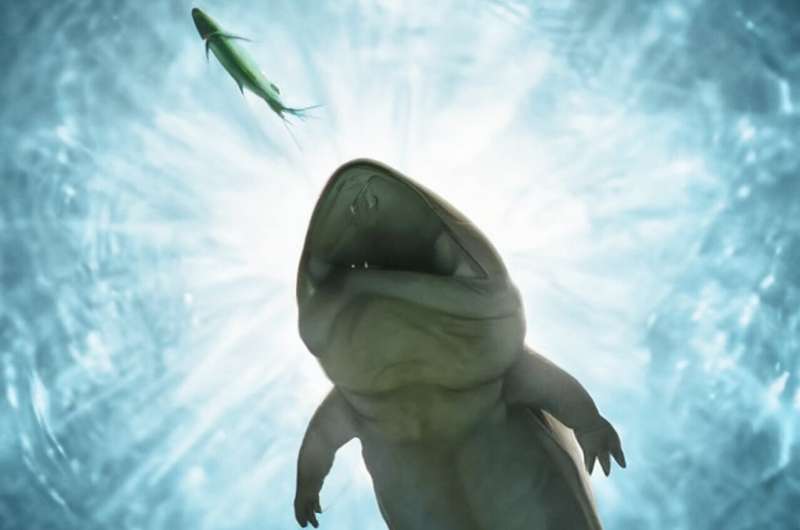
A mystery fossil accidentally unearthed by an Australian chicken farmer in the 1990s has finally been identified as a stout amphibian with tusks and "gnarly teeth", scientists said Wednesday.
The 240 million-year-old fossil was discovered by Mihail Mihailidis as he washed down a massive sandstone slab that was originally destined to become a retaining wall for his garden.
Donated to the Australian Museum in 1997, the near-pristine specimen has puzzled scientists who have labored for almost 30 years to figure out what kind of beast it belonged to.
University of New South Wales paleontologist Lachlan Hart said it had now been identified as a "heavyset" amphibian measuring 1.2 meters (nearly four feet) from snout to tail—resembling a cross between a crocodile and a giant salamander.
He said it likely preyed on freshwater fish, using its "pretty gnarly teeth" and "a pair of fang-like tusks on the roof of its mouth".
"We don't often find skeletons with the head and body still attached, and the soft tissue preservation is an even rarer occurrence," Hart said.
The creature has been given the scientific name of "Arenaerpeton supinatus", which researchers said roughly translated to "supine sand creeper".
It comes from an extinct group of animals known as the "temnospondyls", Hart said, which roamed the planet before the dinosaurs.
Researchers X-rayed the bulky fossil with the help of Australia's border force, which let them run it through a giant scanner more commonly used to search cargo for contraband.
It was found in the mid 1990s near the seaside town of Umina Beach, about one hour's drive north of Sydney in the state of New South Wales.
A blaze of international publicity followed, with Time Magazine suggesting at the time it could "amplify the story of human evolution".
"This is one of the most important fossils found in New South Wales in the past 30 years, so it is exciting to formally describe it," Australian Museum paleontologist Matthew McCurry said.
"It represents a key part of Australia's fossil heritage."
More information: Lachlan J. Hart et al, A new chigutisaurid (Brachyopoidea, Temnospondyli) with soft tissue preservation from the Triassic Sydney Basin, New South Wales, Australia, Journal of Vertebrate Paleontology (2023). DOI: 10.1080/02724634.2023.2232829
© 2023 AFP
Citation: Scientists solve Australian chicken farmer's fossil mystery (2023, August 12) retrieved 12 August 2023 from https://ift.tt/9Xhaj4S
This document is subject to copyright. Apart from any fair dealing for the purpose of private study or research, no part may be reproduced without the written permission. The content is provided for information purposes only.
https://ift.tt/fKnMsoi
Science
No comments:
Post a Comment